Financial Report: Investment Analysis, Portfolio, and Client Advice
VerifiedAdded on 2022/08/18
|39
|8691
|16
Report
AI Summary
This financial report, prepared by a student, provides a comprehensive analysis of investment strategies. It begins with an examination of macroeconomic influences, including global and Vietnamese economic overviews, GDP, inflation, and unemployment rates. The report then delves into industry analysis, focusing on the real estate and food industries. The analysis extends to the corporate level, examining FLC Group and MASAN. The core of the report focuses on building a two-risky-asset portfolio, analyzing FLC and MSN stocks, calculating rates of return, covariance, and correlation to determine the minimum variance frontier and efficient frontier. Finally, the report addresses portfolio selection, comparing the proposed portfolio to the VN-INDEX, and considers client-specific scenarios, including lender/borrower situations, and the calculation of potential fees. The report aims to offer investment advice and portfolio construction strategies based on thorough financial analysis.

Page | 1
Paraphrase This Document
Need a fresh take? Get an instant paraphrase of this document with our AI Paraphraser
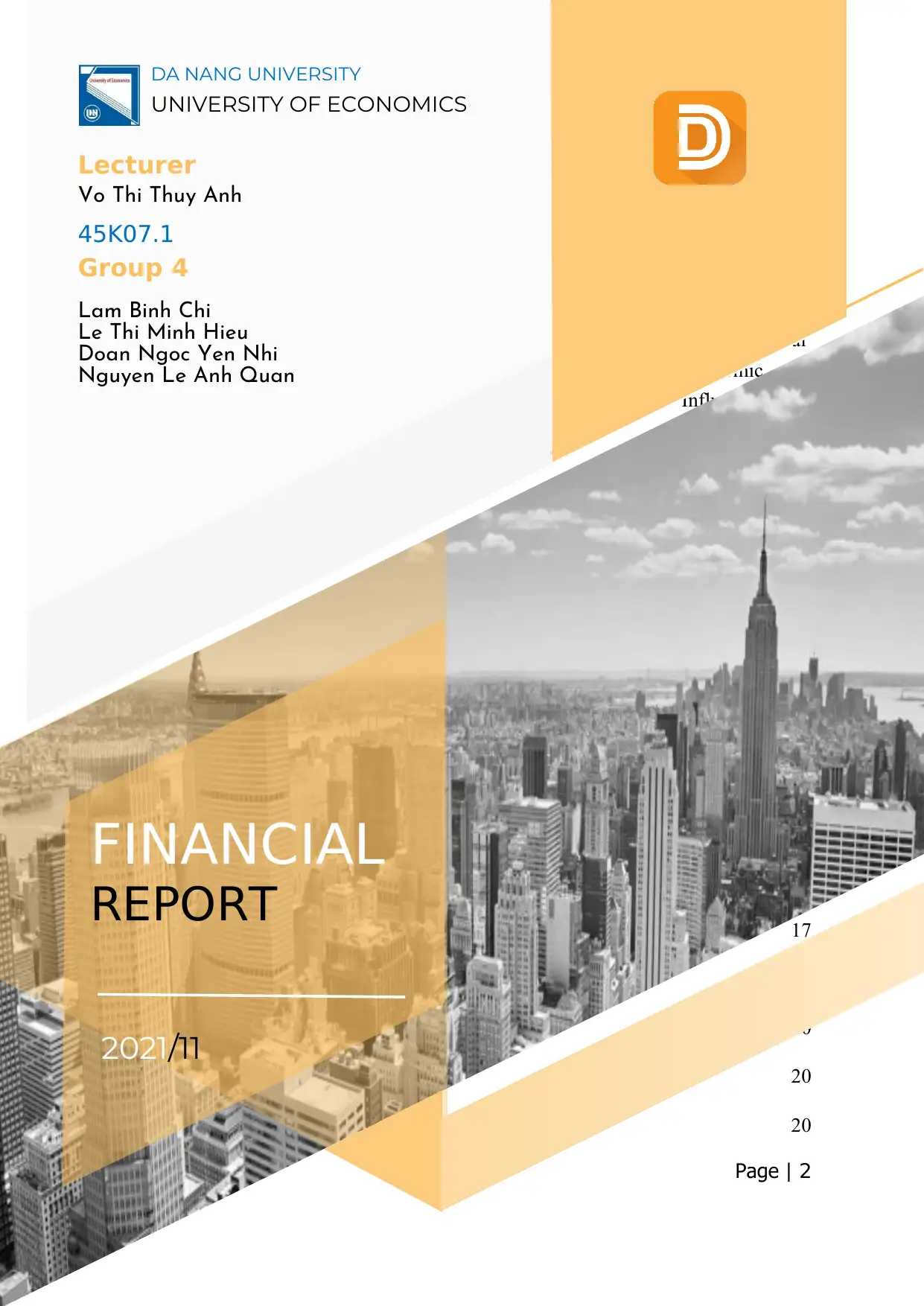
Table of Contents
INTRODUCTION 6
PART 1: THREE-STEP PROCESS 7
1.1. General
Economic
Influences: 7
1.1.1. World
Macroeconomic Overview: 7
1.1.2. Vietnam Macroeconomic Overview: 8
1.1.3 Vietnam Stock Market 14
1.2. Industry Analysis: 16
1.2.1. Real Estate Industry: 17
1.2.2. Food Industry Analysis: 19
1.2.3. Conclusion: 20
1.3. Corporation Analysis: 20
1.3.1. About FLC Group: 20
Page | 2
FINANCIAL
REPORT
Lecturer
Vo Thi Thuy Anh
Group 4
Lam Binh Chi
Le Thi Minh Hieu
Doan Ngoc Yen Nhi
Nguyen Le Anh Quan
45K07.1
2021/11
UNIVERSITY OF ECONOMICS
DA NANG UNIVERSITY
INTRODUCTION 6
PART 1: THREE-STEP PROCESS 7
1.1. General
Economic
Influences: 7
1.1.1. World
Macroeconomic Overview: 7
1.1.2. Vietnam Macroeconomic Overview: 8
1.1.3 Vietnam Stock Market 14
1.2. Industry Analysis: 16
1.2.1. Real Estate Industry: 17
1.2.2. Food Industry Analysis: 19
1.2.3. Conclusion: 20
1.3. Corporation Analysis: 20
1.3.1. About FLC Group: 20
Page | 2
FINANCIAL
REPORT
Lecturer
Vo Thi Thuy Anh
Group 4
Lam Binh Chi
Le Thi Minh Hieu
Doan Ngoc Yen Nhi
Nguyen Le Anh Quan
45K07.1
2021/11
UNIVERSITY OF ECONOMICS
DA NANG UNIVERSITY

1.3.2. About MASAN: 22
PART 2: INVEST IN A TWO-RISKY-ASSET PORTFOLIO AND RISK-FREE
ASSET 26
2.1. Two Stocks Analysis: 26
2.1.1. FLC Stock: 26
2.1.2. MSN Stock: 27
2.2. The Daily Rate Of Return Of Each Stock And VN-INDEX: 28
2.3. The Expected Rate Of Return Of The Stocks And The VN-INDEX: 29
2.4. The Covariance And Correlation Of The Stocks: 29
2.5. The Minimum Variance Frontier And The Efficient Frontier. 30
2.6. Portfolio Selection: 33
PART 3: BUILDING THE PORTFOLIO FOR OUR CLIENTS 35
3.1. Our Portfolio Is Better Than The Market Portfolio (VN-INDEX): 35
3.2. When Clients Are Lender/Borrower: 36
3.3. The Maximum Fee In Percentage That We Could Charge Our Clients: 37
CONCLUSION 39
REFERENCES 40
Page | 3
PART 2: INVEST IN A TWO-RISKY-ASSET PORTFOLIO AND RISK-FREE
ASSET 26
2.1. Two Stocks Analysis: 26
2.1.1. FLC Stock: 26
2.1.2. MSN Stock: 27
2.2. The Daily Rate Of Return Of Each Stock And VN-INDEX: 28
2.3. The Expected Rate Of Return Of The Stocks And The VN-INDEX: 29
2.4. The Covariance And Correlation Of The Stocks: 29
2.5. The Minimum Variance Frontier And The Efficient Frontier. 30
2.6. Portfolio Selection: 33
PART 3: BUILDING THE PORTFOLIO FOR OUR CLIENTS 35
3.1. Our Portfolio Is Better Than The Market Portfolio (VN-INDEX): 35
3.2. When Clients Are Lender/Borrower: 36
3.3. The Maximum Fee In Percentage That We Could Charge Our Clients: 37
CONCLUSION 39
REFERENCES 40
Page | 3
⊘ This is a preview!⊘
Do you want full access?
Subscribe today to unlock all pages.

Trusted by 1+ million students worldwide

Table of Tables
Table 1. Real GDP in the period 2019-2020 and forecast for 2021 5
Table 2. GDP in VN from 2019 to 2021 6
Table 3. Inflation rate in VN from 2019 to 2021 7
Table 4. Unemployment rate in VN from 2019 to 2021 8
Table 5. Exchange rate 11
Table 6. Data about Industry Groups in November, 2021 13
Table 7. The financial information of FLC at 22/10/2021. (Source: tradingview.com)
18
Table 8. The financial information of MSN at 22/10/2021. (Source: tradingview.com)
20
Page | 4
Table 1. Real GDP in the period 2019-2020 and forecast for 2021 5
Table 2. GDP in VN from 2019 to 2021 6
Table 3. Inflation rate in VN from 2019 to 2021 7
Table 4. Unemployment rate in VN from 2019 to 2021 8
Table 5. Exchange rate 11
Table 6. Data about Industry Groups in November, 2021 13
Table 7. The financial information of FLC at 22/10/2021. (Source: tradingview.com)
18
Table 8. The financial information of MSN at 22/10/2021. (Source: tradingview.com)
20
Page | 4
Paraphrase This Document
Need a fresh take? Get an instant paraphrase of this document with our AI Paraphraser

Table of Figures
Figure 1. Vietnam Unemployment rate. Source: tradingeconomics.com 8
Figure 2. Date about Vietnam Balance of trade in 2021. Source: tradingeocomics.com
9
Figure 3. The Interbank Rate of Vietnam in 2021. 12
Page | 5
Figure 1. Vietnam Unemployment rate. Source: tradingeconomics.com 8
Figure 2. Date about Vietnam Balance of trade in 2021. Source: tradingeocomics.com
9
Figure 3. The Interbank Rate of Vietnam in 2021. 12
Page | 5

INTRODUCTION
“Why should we invest in the Stock Market?”
All people really want to get more money and stocks is one of the most popular ways
which is chosen to invest. Investing in stocks has numerous advantages, highlightly
listed the following:
Get profit from idle money without operating the corporations.
Higher potential returns than alternatives such as bank CDs, gold, and government
bonds.
The ability to begin slowly. Investors can start buying stocks with a small amount of
money because many online brokers charge no commissions and allow them to buy
fractional shares.
The ability to diversify one's portfolio across multiple industries.
Therefore, with the majority of advantages given above and the basics of the
Investment Course, our group is going to identify and advise clients which securities
are suitable to invest in.
Financial analysis is used to assess economic trends, set financial policy, create long-
term business plans, and identify projects or companies for investment. This is
accomplished by combining financial numbers and data. In this report, we will not
only point out the three-step process including macroeconomic, industry and
corporation analysis but also have a solid understanding of indices and how to invest
in stocks from all market sectors, as well as consider economic figures and stock
growth.
Page | 6
“Why should we invest in the Stock Market?”
All people really want to get more money and stocks is one of the most popular ways
which is chosen to invest. Investing in stocks has numerous advantages, highlightly
listed the following:
Get profit from idle money without operating the corporations.
Higher potential returns than alternatives such as bank CDs, gold, and government
bonds.
The ability to begin slowly. Investors can start buying stocks with a small amount of
money because many online brokers charge no commissions and allow them to buy
fractional shares.
The ability to diversify one's portfolio across multiple industries.
Therefore, with the majority of advantages given above and the basics of the
Investment Course, our group is going to identify and advise clients which securities
are suitable to invest in.
Financial analysis is used to assess economic trends, set financial policy, create long-
term business plans, and identify projects or companies for investment. This is
accomplished by combining financial numbers and data. In this report, we will not
only point out the three-step process including macroeconomic, industry and
corporation analysis but also have a solid understanding of indices and how to invest
in stocks from all market sectors, as well as consider economic figures and stock
growth.
Page | 6
⊘ This is a preview!⊘
Do you want full access?
Subscribe today to unlock all pages.

Trusted by 1+ million students worldwide
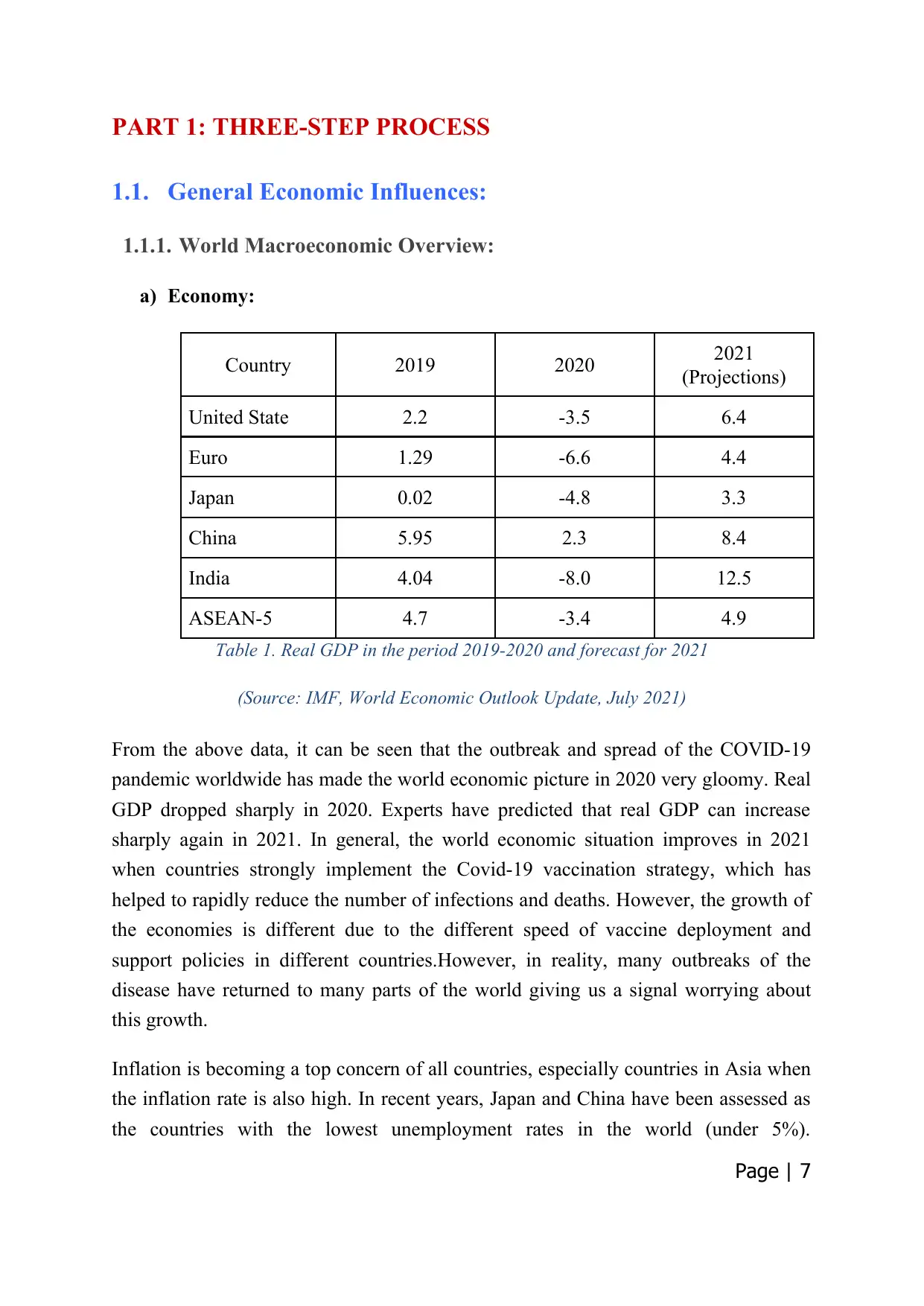
PART 1: THREE-STEP PROCESS
1.1. General Economic Influences:
1.1.1. World Macroeconomic Overview:
a) Economy:
Country 2019 2020 2021
(Projections)
United State 2.2 -3.5 6.4
Euro 1.29 -6.6 4.4
Japan 0.02 -4.8 3.3
China 5.95 2.3 8.4
India 4.04 -8.0 12.5
ASEAN-5 4.7 -3.4 4.9
Table 1. Real GDP in the period 2019-2020 and forecast for 2021
(Source: IMF, World Economic Outlook Update, July 2021)
From the above data, it can be seen that the outbreak and spread of the COVID-19
pandemic worldwide has made the world economic picture in 2020 very gloomy. Real
GDP dropped sharply in 2020. Experts have predicted that real GDP can increase
sharply again in 2021. In general, the world economic situation improves in 2021
when countries strongly implement the Covid-19 vaccination strategy, which has
helped to rapidly reduce the number of infections and deaths. However, the growth of
the economies is different due to the different speed of vaccine deployment and
support policies in different countries.However, in reality, many outbreaks of the
disease have returned to many parts of the world giving us a signal worrying about
this growth.
Inflation is becoming a top concern of all countries, especially countries in Asia when
the inflation rate is also high. In recent years, Japan and China have been assessed as
the countries with the lowest unemployment rates in the world (under 5%).
Page | 7
1.1. General Economic Influences:
1.1.1. World Macroeconomic Overview:
a) Economy:
Country 2019 2020 2021
(Projections)
United State 2.2 -3.5 6.4
Euro 1.29 -6.6 4.4
Japan 0.02 -4.8 3.3
China 5.95 2.3 8.4
India 4.04 -8.0 12.5
ASEAN-5 4.7 -3.4 4.9
Table 1. Real GDP in the period 2019-2020 and forecast for 2021
(Source: IMF, World Economic Outlook Update, July 2021)
From the above data, it can be seen that the outbreak and spread of the COVID-19
pandemic worldwide has made the world economic picture in 2020 very gloomy. Real
GDP dropped sharply in 2020. Experts have predicted that real GDP can increase
sharply again in 2021. In general, the world economic situation improves in 2021
when countries strongly implement the Covid-19 vaccination strategy, which has
helped to rapidly reduce the number of infections and deaths. However, the growth of
the economies is different due to the different speed of vaccine deployment and
support policies in different countries.However, in reality, many outbreaks of the
disease have returned to many parts of the world giving us a signal worrying about
this growth.
Inflation is becoming a top concern of all countries, especially countries in Asia when
the inflation rate is also high. In recent years, Japan and China have been assessed as
the countries with the lowest unemployment rates in the world (under 5%).
Page | 7
Paraphrase This Document
Need a fresh take? Get an instant paraphrase of this document with our AI Paraphraser

Meanwhile, Europe and America remain relatively high. Although these are countries
with highly developed economies, ranked at the top of the world, unemployment still
occurs due to other strict requirements for the labor force.
b) Society:
Epidemics become the world's outstanding events in 2020 whose impact is evident in
2021, and they may even last through 2022 or beyond. If in 2020, countries in Asia,
with good disease control ability, have gradually risen to be more developed, then in
2021, Western countries will gradually regain their position. However, despite facing
the COVID-19 epidemic, many "steps" in peace and cooperation also appeared, such
as the aid of vaccines, pharmaceuticals and medical supplies between countries to help
the bilateral relationship. and multilateralism is getting better and better. Besides, the
issue of competition for power, interests and strategic position among countries,
especially between the US, China and Russia is taking place increasingly fiercely.
That situation leads to an increasing trend of alliances, gathering forces and
confrontational arms races that tend to give rise to hot spots in many regions of the
world, making the world security situation worse.
1.1.2. Vietnam Macroeconomic Overview:
a) GDP:
GDP measures the health of a country's economy. It represents the total value of all
goods and services produced within a country's borders over a specific time period. It
also can be used by investors when making financial decisions: a bad economy means
lower earnings and lower stock prices. When GDP rises, corporate earnings rise,
which is good for stocks. When GDP falls, businesses and consumers spend less,
leading to the markets to fall.
Year 2019 2020 2021
GDP(%) 7.0 2.9 1.9
Table 2. GDP in Vietnam from 2019 to 2021 (Source: https://www.statista.com/)
Page | 8
with highly developed economies, ranked at the top of the world, unemployment still
occurs due to other strict requirements for the labor force.
b) Society:
Epidemics become the world's outstanding events in 2020 whose impact is evident in
2021, and they may even last through 2022 or beyond. If in 2020, countries in Asia,
with good disease control ability, have gradually risen to be more developed, then in
2021, Western countries will gradually regain their position. However, despite facing
the COVID-19 epidemic, many "steps" in peace and cooperation also appeared, such
as the aid of vaccines, pharmaceuticals and medical supplies between countries to help
the bilateral relationship. and multilateralism is getting better and better. Besides, the
issue of competition for power, interests and strategic position among countries,
especially between the US, China and Russia is taking place increasingly fiercely.
That situation leads to an increasing trend of alliances, gathering forces and
confrontational arms races that tend to give rise to hot spots in many regions of the
world, making the world security situation worse.
1.1.2. Vietnam Macroeconomic Overview:
a) GDP:
GDP measures the health of a country's economy. It represents the total value of all
goods and services produced within a country's borders over a specific time period. It
also can be used by investors when making financial decisions: a bad economy means
lower earnings and lower stock prices. When GDP rises, corporate earnings rise,
which is good for stocks. When GDP falls, businesses and consumers spend less,
leading to the markets to fall.
Year 2019 2020 2021
GDP(%) 7.0 2.9 1.9
Table 2. GDP in Vietnam from 2019 to 2021 (Source: https://www.statista.com/)
Page | 8
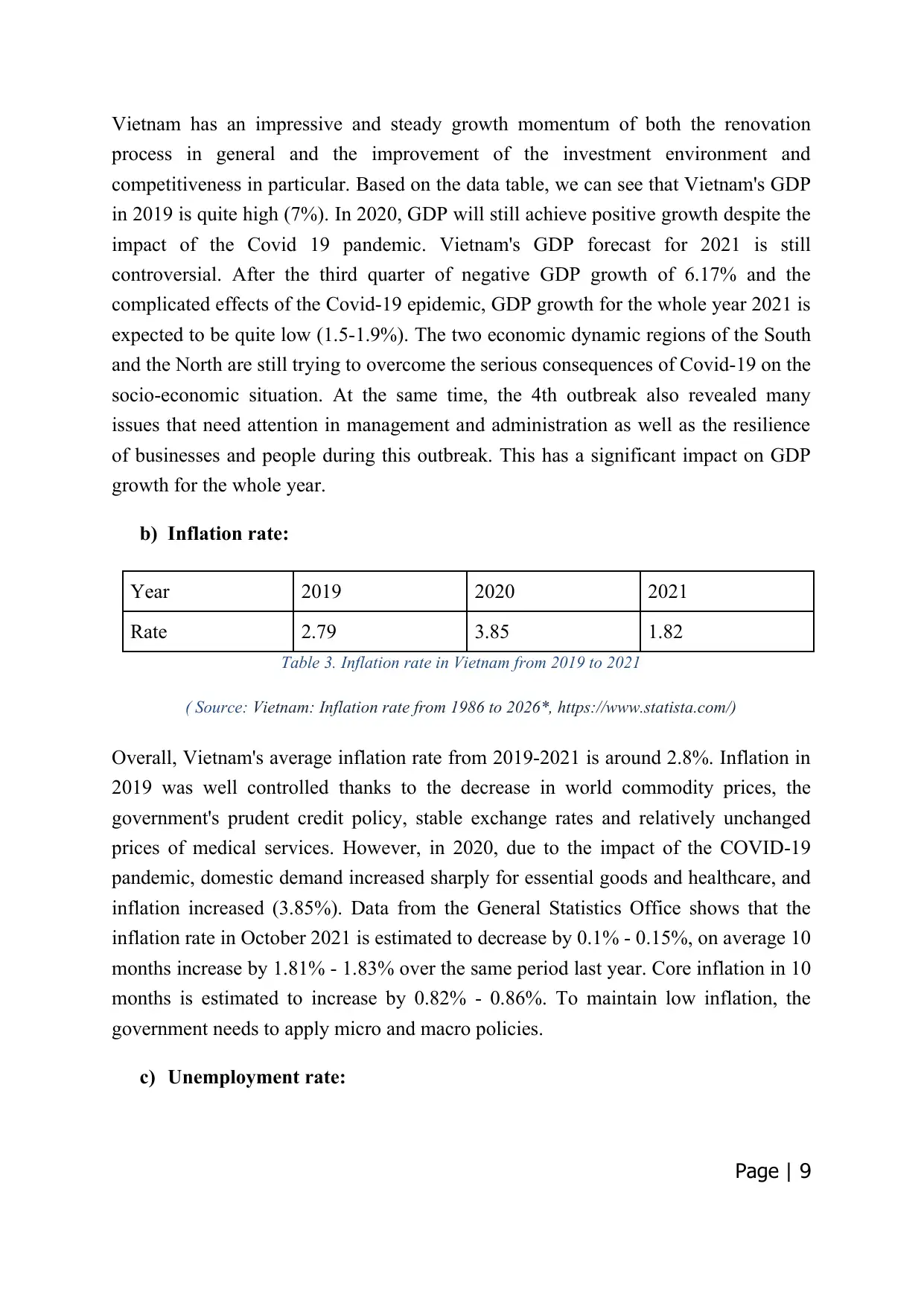
Vietnam has an impressive and steady growth momentum of both the renovation
process in general and the improvement of the investment environment and
competitiveness in particular. Based on the data table, we can see that Vietnam's GDP
in 2019 is quite high (7%). In 2020, GDP will still achieve positive growth despite the
impact of the Covid 19 pandemic. Vietnam's GDP forecast for 2021 is still
controversial. After the third quarter of negative GDP growth of 6.17% and the
complicated effects of the Covid-19 epidemic, GDP growth for the whole year 2021 is
expected to be quite low (1.5-1.9%). The two economic dynamic regions of the South
and the North are still trying to overcome the serious consequences of Covid-19 on the
socio-economic situation. At the same time, the 4th outbreak also revealed many
issues that need attention in management and administration as well as the resilience
of businesses and people during this outbreak. This has a significant impact on GDP
growth for the whole year.
b) Inflation rate:
Year 2019 2020 2021
Rate 2.79 3.85 1.82
Table 3. Inflation rate in Vietnam from 2019 to 2021
( Source: Vietnam: Inflation rate from 1986 to 2026*, https://www.statista.com/)
Overall, Vietnam's average inflation rate from 2019-2021 is around 2.8%. Inflation in
2019 was well controlled thanks to the decrease in world commodity prices, the
government's prudent credit policy, stable exchange rates and relatively unchanged
prices of medical services. However, in 2020, due to the impact of the COVID-19
pandemic, domestic demand increased sharply for essential goods and healthcare, and
inflation increased (3.85%). Data from the General Statistics Office shows that the
inflation rate in October 2021 is estimated to decrease by 0.1% - 0.15%, on average 10
months increase by 1.81% - 1.83% over the same period last year. Core inflation in 10
months is estimated to increase by 0.82% - 0.86%. To maintain low inflation, the
government needs to apply micro and macro policies.
c) Unemployment rate:
Page | 9
process in general and the improvement of the investment environment and
competitiveness in particular. Based on the data table, we can see that Vietnam's GDP
in 2019 is quite high (7%). In 2020, GDP will still achieve positive growth despite the
impact of the Covid 19 pandemic. Vietnam's GDP forecast for 2021 is still
controversial. After the third quarter of negative GDP growth of 6.17% and the
complicated effects of the Covid-19 epidemic, GDP growth for the whole year 2021 is
expected to be quite low (1.5-1.9%). The two economic dynamic regions of the South
and the North are still trying to overcome the serious consequences of Covid-19 on the
socio-economic situation. At the same time, the 4th outbreak also revealed many
issues that need attention in management and administration as well as the resilience
of businesses and people during this outbreak. This has a significant impact on GDP
growth for the whole year.
b) Inflation rate:
Year 2019 2020 2021
Rate 2.79 3.85 1.82
Table 3. Inflation rate in Vietnam from 2019 to 2021
( Source: Vietnam: Inflation rate from 1986 to 2026*, https://www.statista.com/)
Overall, Vietnam's average inflation rate from 2019-2021 is around 2.8%. Inflation in
2019 was well controlled thanks to the decrease in world commodity prices, the
government's prudent credit policy, stable exchange rates and relatively unchanged
prices of medical services. However, in 2020, due to the impact of the COVID-19
pandemic, domestic demand increased sharply for essential goods and healthcare, and
inflation increased (3.85%). Data from the General Statistics Office shows that the
inflation rate in October 2021 is estimated to decrease by 0.1% - 0.15%, on average 10
months increase by 1.81% - 1.83% over the same period last year. Core inflation in 10
months is estimated to increase by 0.82% - 0.86%. To maintain low inflation, the
government needs to apply micro and macro policies.
c) Unemployment rate:
Page | 9
⊘ This is a preview!⊘
Do you want full access?
Subscribe today to unlock all pages.

Trusted by 1+ million students worldwide
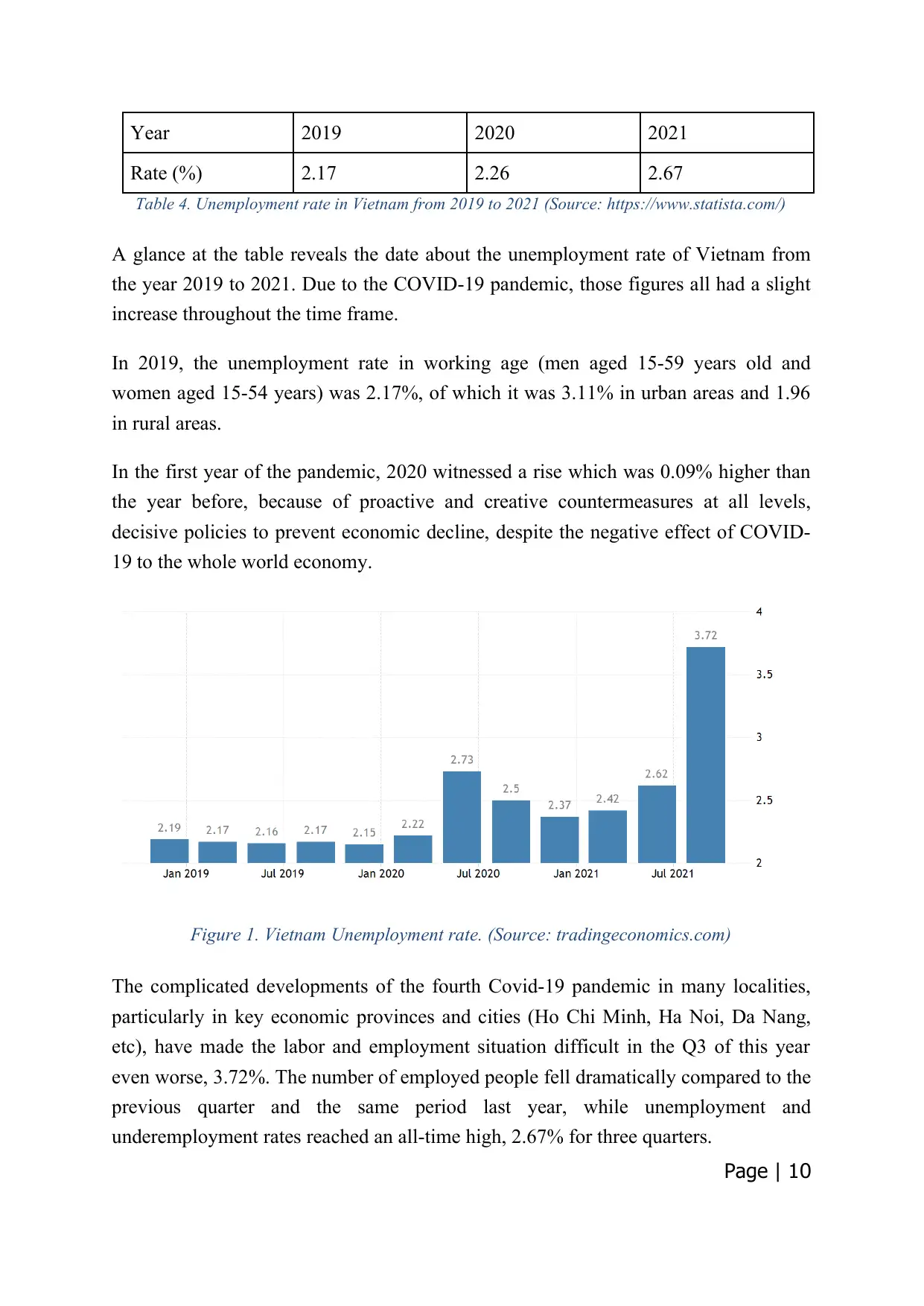
Year 2019 2020 2021
Rate (%) 2.17 2.26 2.67
Table 4. Unemployment rate in Vietnam from 2019 to 2021 (Source: https://www.statista.com/)
A glance at the table reveals the date about the unemployment rate of Vietnam from
the year 2019 to 2021. Due to the COVID-19 pandemic, those figures all had a slight
increase throughout the time frame.
In 2019, the unemployment rate in working age (men aged 15-59 years old and
women aged 15-54 years) was 2.17%, of which it was 3.11% in urban areas and 1.96
in rural areas.
In the first year of the pandemic, 2020 witnessed a rise which was 0.09% higher than
the year before, because of proactive and creative countermeasures at all levels,
decisive policies to prevent economic decline, despite the negative effect of COVID-
19 to the whole world economy.
Figure 1. Vietnam Unemployment rate. (Source: tradingeconomics.com)
The complicated developments of the fourth Covid-19 pandemic in many localities,
particularly in key economic provinces and cities (Ho Chi Minh, Ha Noi, Da Nang,
etc), have made the labor and employment situation difficult in the Q3 of this year
even worse, 3.72%. The number of employed people fell dramatically compared to the
previous quarter and the same period last year, while unemployment and
underemployment rates reached an all-time high, 2.67% for three quarters.
Page | 10
Rate (%) 2.17 2.26 2.67
Table 4. Unemployment rate in Vietnam from 2019 to 2021 (Source: https://www.statista.com/)
A glance at the table reveals the date about the unemployment rate of Vietnam from
the year 2019 to 2021. Due to the COVID-19 pandemic, those figures all had a slight
increase throughout the time frame.
In 2019, the unemployment rate in working age (men aged 15-59 years old and
women aged 15-54 years) was 2.17%, of which it was 3.11% in urban areas and 1.96
in rural areas.
In the first year of the pandemic, 2020 witnessed a rise which was 0.09% higher than
the year before, because of proactive and creative countermeasures at all levels,
decisive policies to prevent economic decline, despite the negative effect of COVID-
19 to the whole world economy.
Figure 1. Vietnam Unemployment rate. (Source: tradingeconomics.com)
The complicated developments of the fourth Covid-19 pandemic in many localities,
particularly in key economic provinces and cities (Ho Chi Minh, Ha Noi, Da Nang,
etc), have made the labor and employment situation difficult in the Q3 of this year
even worse, 3.72%. The number of employed people fell dramatically compared to the
previous quarter and the same period last year, while unemployment and
underemployment rates reached an all-time high, 2.67% for three quarters.
Page | 10
Paraphrase This Document
Need a fresh take? Get an instant paraphrase of this document with our AI Paraphraser

d) Balance of trade:
According to preliminary data, Vietnam's trade surplus dropped to USD 1.1 billion in
October 2021 from USD 2.94 billion the previous year, owing primarily to increasing
imports. Exports increased 0.3% year on year to USD 27.3 billion, while imports rose
8.1% to USD 26.2 billion. The trade goods sector witnessed a USD 1.45 billion deficit
in the first 10 months of this year, as exports continued to increase 16.6% to USD
267.93 billion while imports rose 28.2% to USD 269.38 billion.
Figure 2. Date about Vietnam Balance of trade in 2021. (Source: tradingeocomics.com)
e) Monetary and Fiscal Policy:
The year 2020 witnessed a success in terms of the coordination and administration of
the Government's, ministries', and branches' macroeconomic policies. In specific, the
co-ordination and management of fiscal policies - monetary policy - remained a
shining light in the sense of the Covid-19 pandemic, African swine fever pandemic,
natural disasters, floods, saline intrusion, and other unexpected figures in all aspects of
socioeconomic life.
Total state budget expenditure in 2020 was at 1,781.4 trillion VND, equivalent to
82.8% of the plan submitted to the National Assembly. A positive light in the
management is the improvement in the public investment disbursement progress
compared to the previous year. Investment and development spending was estimated
Page | 11
According to preliminary data, Vietnam's trade surplus dropped to USD 1.1 billion in
October 2021 from USD 2.94 billion the previous year, owing primarily to increasing
imports. Exports increased 0.3% year on year to USD 27.3 billion, while imports rose
8.1% to USD 26.2 billion. The trade goods sector witnessed a USD 1.45 billion deficit
in the first 10 months of this year, as exports continued to increase 16.6% to USD
267.93 billion while imports rose 28.2% to USD 269.38 billion.
Figure 2. Date about Vietnam Balance of trade in 2021. (Source: tradingeocomics.com)
e) Monetary and Fiscal Policy:
The year 2020 witnessed a success in terms of the coordination and administration of
the Government's, ministries', and branches' macroeconomic policies. In specific, the
co-ordination and management of fiscal policies - monetary policy - remained a
shining light in the sense of the Covid-19 pandemic, African swine fever pandemic,
natural disasters, floods, saline intrusion, and other unexpected figures in all aspects of
socioeconomic life.
Total state budget expenditure in 2020 was at 1,781.4 trillion VND, equivalent to
82.8% of the plan submitted to the National Assembly. A positive light in the
management is the improvement in the public investment disbursement progress
compared to the previous year. Investment and development spending was estimated
Page | 11
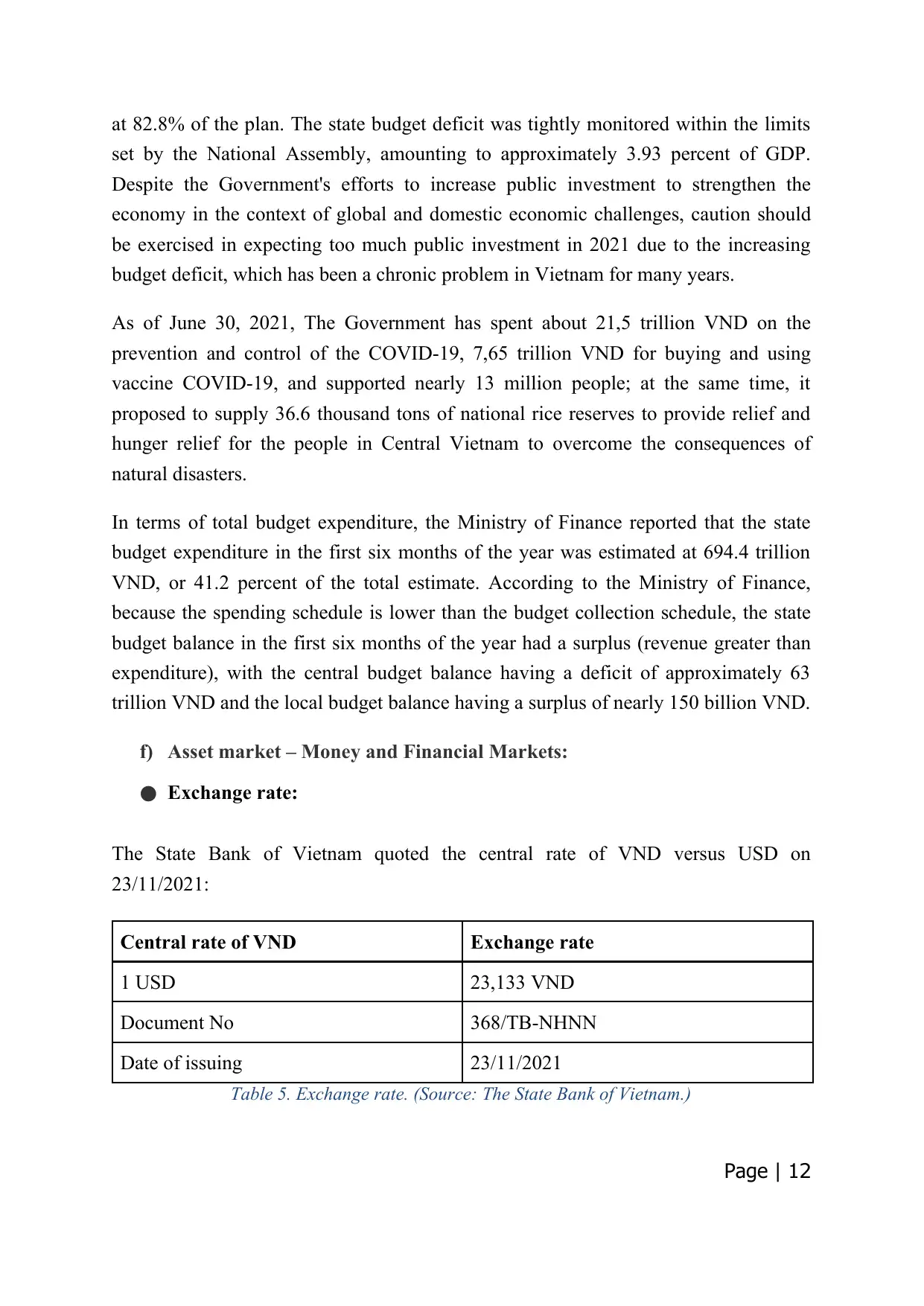
at 82.8% of the plan. The state budget deficit was tightly monitored within the limits
set by the National Assembly, amounting to approximately 3.93 percent of GDP.
Despite the Government's efforts to increase public investment to strengthen the
economy in the context of global and domestic economic challenges, caution should
be exercised in expecting too much public investment in 2021 due to the increasing
budget deficit, which has been a chronic problem in Vietnam for many years.
As of June 30, 2021, The Government has spent about 21,5 trillion VND on the
prevention and control of the COVID-19, 7,65 trillion VND for buying and using
vaccine COVID-19, and supported nearly 13 million people; at the same time, it
proposed to supply 36.6 thousand tons of national rice reserves to provide relief and
hunger relief for the people in Central Vietnam to overcome the consequences of
natural disasters.
In terms of total budget expenditure, the Ministry of Finance reported that the state
budget expenditure in the first six months of the year was estimated at 694.4 trillion
VND, or 41.2 percent of the total estimate. According to the Ministry of Finance,
because the spending schedule is lower than the budget collection schedule, the state
budget balance in the first six months of the year had a surplus (revenue greater than
expenditure), with the central budget balance having a deficit of approximately 63
trillion VND and the local budget balance having a surplus of nearly 150 billion VND.
f) Asset market – Money and Financial Markets:
● Exchange rate:
The State Bank of Vietnam quoted the central rate of VND versus USD on
23/11/2021:
Central rate of VND Exchange rate
1 USD 23,133 VND
Document No 368/TB-NHNN
Date of issuing 23/11/2021
Table 5. Exchange rate. (Source: The State Bank of Vietnam.)
Page | 12
set by the National Assembly, amounting to approximately 3.93 percent of GDP.
Despite the Government's efforts to increase public investment to strengthen the
economy in the context of global and domestic economic challenges, caution should
be exercised in expecting too much public investment in 2021 due to the increasing
budget deficit, which has been a chronic problem in Vietnam for many years.
As of June 30, 2021, The Government has spent about 21,5 trillion VND on the
prevention and control of the COVID-19, 7,65 trillion VND for buying and using
vaccine COVID-19, and supported nearly 13 million people; at the same time, it
proposed to supply 36.6 thousand tons of national rice reserves to provide relief and
hunger relief for the people in Central Vietnam to overcome the consequences of
natural disasters.
In terms of total budget expenditure, the Ministry of Finance reported that the state
budget expenditure in the first six months of the year was estimated at 694.4 trillion
VND, or 41.2 percent of the total estimate. According to the Ministry of Finance,
because the spending schedule is lower than the budget collection schedule, the state
budget balance in the first six months of the year had a surplus (revenue greater than
expenditure), with the central budget balance having a deficit of approximately 63
trillion VND and the local budget balance having a surplus of nearly 150 billion VND.
f) Asset market – Money and Financial Markets:
● Exchange rate:
The State Bank of Vietnam quoted the central rate of VND versus USD on
23/11/2021:
Central rate of VND Exchange rate
1 USD 23,133 VND
Document No 368/TB-NHNN
Date of issuing 23/11/2021
Table 5. Exchange rate. (Source: The State Bank of Vietnam.)
Page | 12
⊘ This is a preview!⊘
Do you want full access?
Subscribe today to unlock all pages.

Trusted by 1+ million students worldwide
1 out of 39
Your All-in-One AI-Powered Toolkit for Academic Success.
+13062052269
info@desklib.com
Available 24*7 on WhatsApp / Email
![[object Object]](/_next/static/media/star-bottom.7253800d.svg)
Unlock your academic potential
Copyright © 2020–2025 A2Z Services. All Rights Reserved. Developed and managed by ZUCOL.